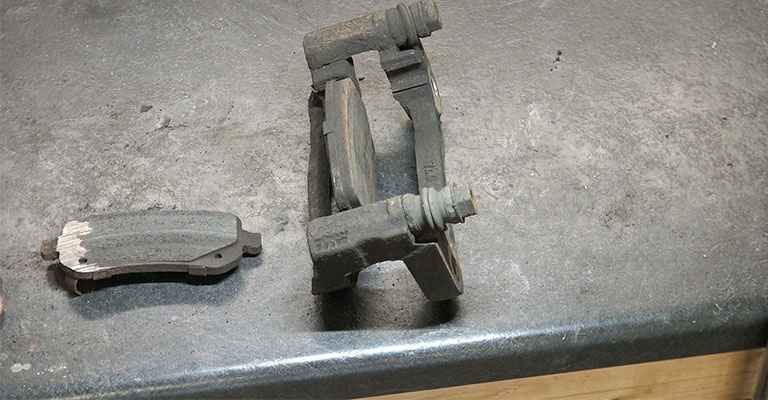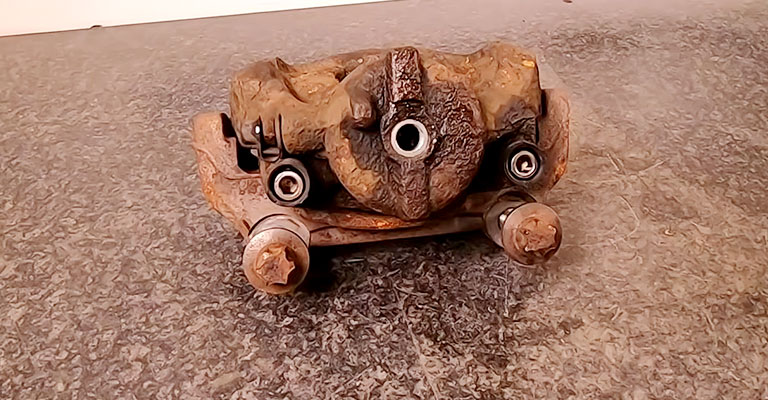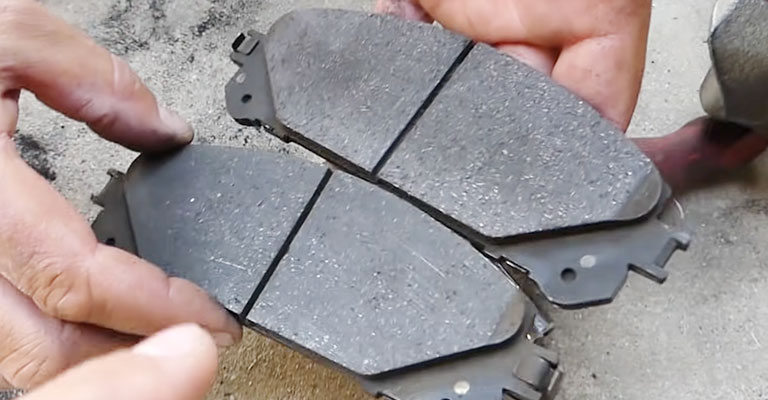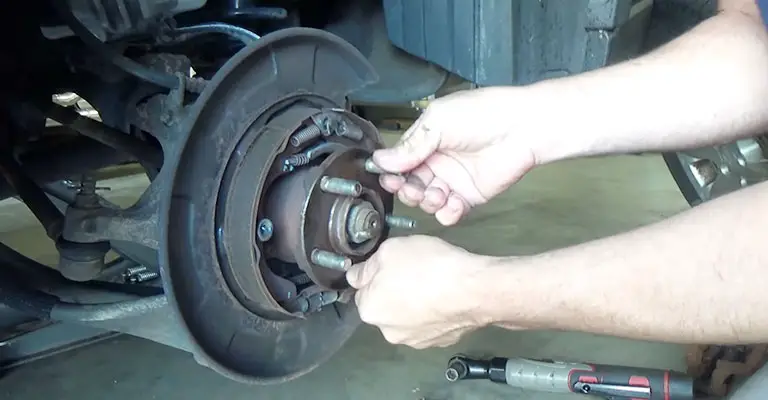Almost every car owner has experienced rumbling, squeaking, or grinding sounds. If you’re also experiencing a low rumbling sound when braking then this guide comes with some valuable insights for you.
Rumbling sounds while braking originates mainly from worn-out disks, damaged shims, rotors, etc. But you can fix this problem by taking off the wheels, inspecting the brake, and making necessary repairs.
In most cases, rumbling sounds can be fixed by lubricating, but in extreme scenarios, a complete replacement is needed.
Today, we’ll talk about the reasons why the brake is making sounds, how to fix it, and also provide you with additional information in this regard. Let’s start without further ado!
What Causes the Rumbling Sounds
Rumbling sounds are caused by several reasons notably – worn-out brake pads or damaged rotors. In this section, we’ll go over 4 possible reasons behind rumbling braking sounds. Continue reading to know more:
Reason 1 – Worn Out Brake Pads

Worn-out brake pads are the main reason for rumbling sounds. Gradual usage wears down the pads. When the pad material wears out completely, the metal part comes in contact with the rotor, causing squeaking or grinding noises.
Reason 2 – Dirt or Debris
It is common for small rocks, dirt or other debris to get stuck between the rotor and pads. When the brakes are engaged, these lodged materials make grinding or rumbling sounds.
Regular washes remove these impurities and keep the braking system clean. Additionally, you can disassemble the pads to thoroughly clean them.
Reason 3 – Damaged Rotors and Shims
Rotors surfaces need to be smooth to function properly. But stuck debris or worn brake pads can scratch the surface. Eventually, this wear and tear will severely damage the rotors.
A worn-out shim will also make metal-to-metal contact and produce knocking sounds while driving. In such cases, you will experience mild vibration and grinding noises while braking.
Reason 4 – Unlubricated Calipers and Rust

If you don’t lubricate the caliper properly it may get stuck and make grinding sounds. Also, rust can build up in certain parts if you leave the car in a moist environment. Rust build-up results in squealing noises.
3 Easy Steps to Fix Rumbling Brake Sounds
Now that you know the various causes of braking sounds, it’s time to resolve these issues. In this part, we’ll talk about how to diagnose and fix rumbling sounds in 3 simple steps –
Step 1 – Disassemble the Wheels and Look for Loose Parts
Firstly, take off the wheels and try to wiggle the brake pads, rotors, and calipers. These parts should be firmly held in place by bolts or clips. If you notice the parts are moving, then one or more clips could be missing.
Loose parts are responsible for vibration and rumbling noises. This is fixed by attaching the parts to their proper places. Loose parts can also lead to complete brake failure. So, we suggest performing the necessary repairs as soon as possible.
Step 2 – Check for Worn Brake Pads

Now, take off the brake pads and check for wear and tear. Most pads have a small metal piece attached to the sides, which makes squeaking noises when pads wear out.
The uneven pad surface also makes grinding sounds. If your car has pads of different sizes, then eventually it will ride to the disk’s edge. In time, misaligned contact between the disk and pads will lead to premature deterioration.
You can fix this problem by sanding down the brake pads using a sanding belt or by hand. If there’s too much wear, then consider changing the pads.
Step 3 – Inspect the Brake Rotors for Possible Damage
Do a quick inspection of the rotors after you’ve checked the brake pads. Damaged brake rotors increase brake pad wear.
Look for warping or deep surface scratches. Rotors need a smooth surface to function so a worn disk may require machine resurfacing. But check if the rotor thickness is okay or not before machining.
Resurfacing is an easy and economic substitute for rotor replacement. However, a replacement is crucial if the surface distortion is too much.
Different Types of Noises While Braking and What They Mean
Mild rumbling noises could mean several problems. Thus, you can understand a specific problem by isolating the sound. Here are the 3 most common sounds associated with a faulty braking system –
Type 1 – Grinding Noises When Braking

Grinding sounds typically mean there’s been severe damage to the brake pads and this should not be ignored. This is a major sign that your brake calipers or rotors need replacement. Luckily, replacements are easy and don’t cost a lot.
Type 2 – High-Pitch Squealing Noises
Squealing sounds are often caused by rust build-up on the rotors. The sound generates when rusted rotors come in contact with the brake pads. Parking the car in a damp garage can cause this problem.
However, don’t be alarmed as this doesn’t cause permanent damage. And the sound generally goes away on its own after driving for a few miles.
Metal parts are bound to rust and the brake rotors are no exception. But you can avoid this by routinely lubricating the rotors.
Type 3 – Squeaking Sounds At Low Speeds
This is by far the most irritating noise you’ll encounter. Such a sound originates from the brake pads. Low-end pads have loose metal grits and they make scraping or squeaking noises when you brake.
Damaged or worn-out pads can also cause this sound. Checking the wear indicators on the brake will let you know whether the pads need replacement or not.
Additionally, worn-out or low-quality pads can also harm the brake rotors. So, get the pad diagnosed if you encounter squeaking sounds.
Brake Replacement Expenses
Brake pads usually come in a set of 2 and good-quality sets start at 80 dollars. So, changing only the brake pads fall between 200-500 dollars. However, replacing the entire system will cost between 500-1000 dollars. This includes tax and labor costs.
The necessity of Changing the Brake Fluid
Worn-out pads need more fluid pressure to achieve the necessary braking friction. Over time, this will use up the brake fluid deposit.
Low fluid pressure can lead to stiff brake pedals, difficulty stopping, unresponsive brakes, etc. If left unattended these issues can lead to severe accidents.
So, it’s important to regularly check and change the brake fluid. However, there’s no specific guideline on when you need to refill the fluids. Just to be safe, you should check the fluid every 30,000-45,000 miles.
Tips for Taking Care of the Brakes
Here are some useful tips that’ll help you take care of the brake and increase their longevity –
- Check and refill brake fluid every 3-4 months.
- Consider draining and changing the brake fluid after driving 30,000 miles,
- Inspect the brake disks every 10,000 miles.
- Keep the calipers properly lubricated.
- Store the car in a dry enclosed room.
Frequently Asked Questions
- How Long do Ceramic Brake Pads Last?
Although ceramic brake pads are extremely durable, their longevity depends on your driving style and road conditions. Ceramic pads last about 75,000 miles compared to other material that lasts only 25,000-30000 miles.
- Can I Drive with Brake Judder?
In short, no. Driving with faulty brakes is dangerous. Slowing down with a worn-out brake takes longer and you won’t stop in time to avoid collisions on road. We highly urge you to change the brakes as soon as possible.
- How do I Know When to Replace Brake Disk?
Inspect the brake disks and observe whether the disks are smooth or not. If you notice grooves, then they may need a replacement. Another way to check the integrity is by listening to braking sounds. Squeaking sound and vibration could indicate a faulty disk.
- How often Should I Change the Brake Pads?
We recommend changing the pads in intervals of 12,000 miles. Generally, brake pads have a service life of 10,000-15,000 miles. But this value varies depending on your driving habits and road conditions.
Conclusion
To wrap up, a low rumbling sound while braking can indicate several problems like broken rotor disks, worn-out brake pads, misaligned calipers, damaged shims, etc. You can isolate the problem depending on the type of sound.
The best and easiest method is to disassemble the wheels and run a thorough inspection. If you’re lucky then the problem can be fixed by replacing the brake pads or lubricating the calipers.
In extreme cases, the entire braking system might need a replacement. Replacements costs around 500-1000 dollars. However, this is a complicated task and you should consult a skilled mechanic to fix this.
Leave a Reply